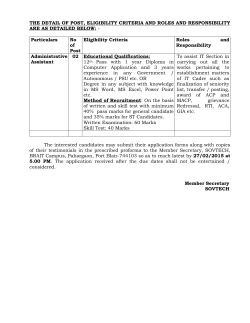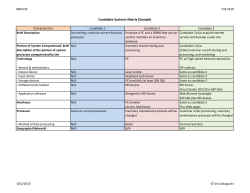
Schema Refinement & Normalization Theory 2
Schema Refinement &
Normalization Theory 2
Week 15
1
How do we know R is in BCNF?
• If R has only two attributes, then it is in
BCNF
• If F only uses attributes in R, then:
– R is in BCNF if and only if for each X → Y in
F (not F+!), X is a superkey of R, i.e., X → R is
in F+ (not F!).
2
Checking for BCNF Violations
• List all non-trivial FDs
• Ensure that left hand side of each FD is a
superkey
• We have to first find all the keys!
3
Checking for BCNF Violations
• Is Courses(course_num, dept_name, course_name,
classroom, enrollment, student_name, address) in BCNF?
• FDs are:
– course_num, dept_name → course_name
– course_num, dept_name → classroom
– course_num, dept_name → enrollment
• What is (course_num, dept_name)+?
– {course_num, dept_name, course_name, classroom, enrollment}
• Therefore, the key is
{course_num, dept_name, course_name, classroom, enrollment,
student_name, address}
• The relation is not in BCNF
4
BCNF and Dependency Preservation
• In general, there may not be a dependency
preserving decomposition into BCNF.
• Example: schema CSZ (city, street_name,
zip_code) with FDs: CS → Z, Z → C
(city, street_name) → zip_code
zip_code → city
• Can’t decompose while preserving CS → Z,
but CSZ is not in BCNF.
5
Example Regarding Dependency
Preservation
• R = (A, B, C)
F = {A → B, B → C)
– Can be decomposed in two different ways
• R1 = (A, B), R2 = (B, C)
– Lossless-join decomposition:
R1 ∩ R2 = {B} and B → BC
– Dependency preserving
• R1 = (A, B), R2 = (A, C)
– Lossless-join decomposition:
R1 ∩ R2 = {A} and A → AB
– Not dependency preserving
(cannot check B → C without computing R1
R2)
6
Dependency Preserving Decomposition
• Consider CSJDPQV, C is key, JP → C and
SD → P.
–
–
BCNF decomposition: CSJDQV and SDP
Problem: Checking JP → C requires a join!
• Dependency preserving decomposition
(Intuitive):
–
If R is decomposed into X, Y and Z, and we
enforce the FDs that hold on X, on Y and on Z,
then all FDs that were given to hold on R must
also hold. (Avoids Problem (3))
7
What FD on a decomposition?
• Projection of set of FDs F: If R is
decomposed into X, ... the projection of F
onto X (denoted FX ) is the set of FDs U →
V in F+ (closure of F ) such that U, V are in
X.
8
Dependency Preserving Decompositions
(Contd.)
• Decomposition of R into X and Y is dependency preserving
if (FX union FY ) + = F +
–
i.e., if we consider only dependencies in the closure F + that can be
checked in X without considering Y, and in Y without considering
X, these imply all dependencies in F +.
• Important to consider F +, not F, in this definition:
–
–
ABC, A → B, B → C, C → A, decomposed into AB and BC.
Is this dependency preserving? Is C → A preserved?????
• Dependency preserving does not imply lossless join:
–
ABC, A → B, decomposed into AB and BC.
• And vice-versa!
9
Another example
• Assume CSJDPQV is decomposed into
SDP, JS, CJDQV
It is not dependency preserving
w.r.t. the FDs: JP → C, SD → P and J → S.
• However, it is a lossless join decomposition.
• In this case, adding JPC to the collection of relations gives
us a dependency preserving decomposition.
• JPC tuples stored only for checking FD!
10
Summary of BCNF
• If a relation is in BCNF, it is free of redundancies that can
be detected using FDs. Thus, trying to ensure that all
relations are in BCNF is a good heuristic.
• If a relation is not in BCNF, we can try to decompose it
into a collection of BCNF relations.
– It is always possible to decompose a relation into a set of
relations that are in BCNF such that:
• the decomposition is lossless
• it may not be possible to preserve dependencies.
11
Next: Third Normal Form
• There are some situations where
– BCNF is not dependency preserving, and
– efficient checking for FD violation on updates is
important
• Solution: define a weaker normal form, called
Third Normal Form (3NF)
– Allows some redundancy (with resultant problems; we
will see examples later)
– But functional dependencies can be checked on
individual relations without computing a join.
– There is always a lossless-join, dependency-preserving
decomposition into 3NF.
12
Third Normal Form (3NF)
• If R is in BCNF, obviously in 3NF.
• If R is in 3NF, some redundancy is possible.
It is a compromise, used when BCNF not
achievable (e.g., no “good” decomposition,
or performance considerations).
–
Lossless-join, dependency-preserving
decomposition of R into a collection of 3NF
relations always possible.
13
3NF
• Relation R with FDs F is in 3NF if, for each FD
X → A (X ∈ R and A ∈ R) in F, one of the
following statements is true:
– A ∈ X (trivial FD), or
– X is a superkey, or
– A is part of some key for R
If one of these two is
satisfied for ALL FDs, then
R is in BCNF
Not just superkey! (why not?)
14
What Does 3NF Achieve?
• If 3NF is violated by X→A, one of the following holds:
–
X is a subset of some key K (partial redundancy)
• We store (X, A) pairs redundantly.
–
X is not a proper subset of any key.
• There is a chain of FDs K → X → A, which means that we cannot
associate an X value with a K value unless we also associate an A value
with an X value.
• But: even if reln is in 3NF, these problems could arise.
–
e.g., Reserves SBDC (sid, bid, date, credit_card). Keys are SBD, CBD.
FD = {S →C, C →S}. R is in 3NF, but for each reservation of sailor S,
same (S, C) pair is stored.
• Thus, 3NF is indeed a compromise relative to BCNF.
15
Decomposition into 3NF
• Obviously, the algorithm for lossless join decomp
into BCNF can be used to obtain a lossless join
decomp into 3NF (typically, can stop earlier).
• To ensure dependency preservation, one idea:
–
–
•
If X → Y is not preserved, add relation XY.
Problem is that XY may violate 3NF!
Refinement: Instead of the given set of FDs F,
use a minimal cover for F.
16
Minimal Cover for a Set of FDs
• Minimal cover G for a set of FDs F:
–
–
–
Closure of F = closure of G.
Right hand side of each FD in G is a single attribute.
If we modify G by deleting an FD or by deleting
attributes from an FD in G, the closure changes.
• Intuitively, every FD in G is needed, and as small
as possible in order to get the same closure as F.
17
Obtaining Minimal Cover
• Step 1: Put the FDs in a standard form (i.e.
right-hand side should contain only single
attribute)
• Step 2: Minimize the left side of each FD
• Step 3: Delete redundant FDs
18
• Find minimal cover for F = {ABH → CK,
A → D, C → E, BGH → L, L → AD, E →
L, BH → E}
19
• Step 1: Make RHS of each FD into a single
attribute:
F = {ABH → C, ABH → K, A → D, C → E,
BGH → L, L → A, L → D, E → L, BH → E}
20
• F = {ABH → C, ABH → K, A → D, C → E, BGH → L, L → A, L
→ D, E → L, BH → E}
• Step 2: Eliminate redundant attributes from LHS, e.g. Can an
attribute be deleted from ABH → C?
– Compute (AB)+, (BH)+, (AH)+ and see if any of them contains C. (Why?)
– (AB)+ = ABD, (BH)+ = ABCDEHKL, (AH)+ = ADH. Since C ∈ (BH)+, BH
→ C is entailed by F. So A is redundant in ABH → C. Similarly, A is also
redundant in ABH → K. Check further to see if B or H is redundant as well.
– Similarly, for BGH → L, G is redundant since L ∈ (BH)+.
– F = {BH → C, BH → K, A → D, C → E, BH → L, L → A, L → D, E → L,
BH → E}
21
• F = {BH → C, BH → K, A → D, C → E, BH → L, L → A, L
→ D, E → L, BH → E}
• Step 3: Delete redundant FDs from F.
– If F – {f} infers f, then f is redundant, i.e. if f is X → A, then check if X+
using F – f still contains A. If it does, then it means X → A can be inferred
by other FDs.
– E.g. For BH → L, (BH)+ (not using BH → L) = ACDEKL, which
contains L. This means BH → L can be inferred by other FDs, so it s a
redundant FD.
– In fact, BH → L can be inferred by BH → E, E → L.
– Check other FDs using the same algorithm.
• Note: the order of Step 2 and Step 3 should not be exchanged.
22
What to do with Minimal Cover?
• After obtaining the minimal cover, for each FD X→ A in
the minimal cover that is not preserved, create a table
consisting of XA (so we can check dependency in this new
table, i.e. dependency is preserved).
• Why is this new table guaranteed to be in 3NF (whereas if
we created the new table from F, it might not?)
– Since X → A is in the minimal cover, Y → A does not hold for
any Y that is a strict subset of X.
• So X is a key for XA (satisfies condition #2)
• If any other dependencies hold over XA, the right side can involve
only attributes in X because A is a single attribute (satisfies condition
#3).
23
Comparison of BCNF and 3NF
• It is always possible to decompose a relation into a set of
relations that are in 3NF such that:
– the decomposition is lossless
– the dependencies are preserved
• It is always possible to decompose a relation into a set of
relations that are in BCNF such that:
– the decomposition is lossless
– it may not be possible to preserve dependencies.
24
Normalization Review
• Identify all FD s in F+
• Identify candidate keys
• Identify (strongest, or specific) normal forms
– BCNF, 3NF
• Schema decomposition
– When to decompose
– How to check if a decomposition is lossless-join and/or dependency
preserving
• Use projection of F+ to check for dependency preservation
– Decompose into:
• Lossless-join
• Dependency preserving
– Use minimal cover
25
Normalization Theory Practice Questions
Example
A
1
1
2
2
B
1
1
2
2
C
2
3
3
2
FDs with A as
the left side:
Satisfied by the
relation?
A→A
A→B
A→C
AB →A
AC →B
Yes (trivial FD)
Yes
No: tuples 1&2
Yes (trivial FD)
Yes
27
Example
Let F={ A → BC, B →C }. Is C →AB in F+?
Answer: No. Either of the following 2
reasons is ok:
Reason 1) C+=C, and does not include AB.
Reason 2) We can find a relation instance
such that it satisfies F but does not satisfy
C → AB.
A B C
1
2
1
1
2
2
28
List all the non-trivial FDs in F+
• Given F={ A → B, B → C}. Compute F+
(with attributes A, B, C).
A
B
C
AB
AC
BC
ABC
A B C AB AC BC ABC
√ √ √
√
√ √
√
√
Attribute closure
A+=ABC
B+=BC
C+=C
√
√
√
√
√
√
√
√
AB+=ABC
AC+=ABC
BC+=BC
ABC+=ABC
29
Example
• Given F={ A → B, B → C}. Find a relation that
satisfies F:
A
1
2
B
1
1
C
2
2
• Given F={ A → B, B → C}. Find a relation that
satisfies F but does not satisfy B → A. Well, the
above example suffices.
• Can you find an instance that satisfies F but not
A → C? No. Because A → C is in F+
30
Examples
R(A, B, C, D, E),
F = {A → B, C → D}
Candidate key: ACE. How do we know?
Intuitively,
- A is not determined by any other attributes (like E),
and A has to be in a candidate key (because a
candidate key has to determine all the attributes).
- Now if A is in a candidate key, B cannot be in the same
candidate key, since we can drop B from the candidate
without losing the property of being a key .
- So B cannot be in a candidate key
- Same reasoning apply to others attributes.
31
Example
R(A, B, C, D, E),
F = {A → B, C → D} [Same as previous]
Which normal form?
Not in BCNF. This is the case where all attributes in
the FDs appear in R. We consider A, and C to see if
either is a superkey of not. Obviously, neither A nor
C is a superkey, and hence R is not in BCNF. More
precisely, we have A → B is in F+ and non-trivial,
but A is not a superkey of R.
32
Example
R(A, B, C, D, E)
F = {A → B, C → D} [Same as previous]
Which normal form?
We already know that it s not in BCNF.
Not in 3NF either. We have A → B is in F+ and non-trivial,
but A is not a superkey of R. Furthermore, B is not
in any candidate key (since the only candidate key
is ACE).
33
Example
• R(A,B,F), F = {AC → E, B → F}.
• Candidate key? AB
• BCNF? No, because of B → F (B is not a
superkey).
• 3NF? No, because of B → F (F is not part of a
candidate key).
34
Example
•
•
•
•
R(D, C, H, G), F = {A → I, I → A}
Candidate key? DCHG
BCNF? Yes
3NF? Yes
35
Example
• R(A, B, C, D, E, G, H)
F={AB → C, AC → B, B → D, BC → A, E → G}
• Candidate keys?
–
–
–
–
H has to be in all candidate keys
E has to be in all candidate keys
G cannot be in any candidate key (since E is in all candidate keys already).
Since AB → C, AC → B and BC → A, we know no candidate key can
have ABC together.
– AEH, BEH, CEH are not superkeys.
– Try ABEH, ACEH, BCEH. They are all superkeys. And we know they are
all candidate keys (since above properties)
– These are the only candidate keys: (1) each candidate key either contains
A, or B, or C since no attributes other than A,B,C determine A, B, C, and
(2) if a candidate key contains A, then it must contain either B, or C, and
so on.
36
Example
• Same as previous
• Not in BCNF, not in 3NF
• Decomposition:
R(A, B, C, D, E, G, H)
F={AB → C, AC → B, B → D,
BC → A, E → G}
ABCDEGH
BD
Using B → D
ABCEGH
ABC
Using AB → C
ABEGH
EG
Using E → G
ABEH
37
Example
• R(A, B, C, D, E, G, H)
F={AB → C, AC → B, B → D, BC → A, E →
G}
• Decomposition: BD, ABC, EG, ABEH
• Why good decomposition?
– They are all in BCNF
– Lossless-join decomposition
– All dependencies are preserved.
38
Example
• R(A, B, D, E) decomposed into R1(A, B, D), R2
(A, B, E)
• F={AB → DE}
• It is a dependency preserving decomposition!
– AB → D can be checked in R1
– AB → E can be checked in R2
– {AB → DE} is equivalent to {AB → D, AB → E}
39
© Copyright 2025











